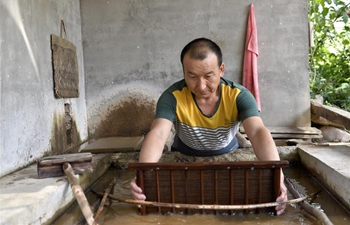BEIJING, July 24 (Xinhua) -- A research team from Southwest Petroleum University in Sichuan Province has developed a low-cost, high-efficiency photocatalyst that uses visible light to purify water.
A photocatalyst is a substance that can help cause a light-catalyzed reaction, such as chlorophyll capturing sunlight to turn water and carbon dioxide into oxygen and glucose in photosynthesis.
Ordinary photocatalysts can decompose organic pollutants in sewage under ultraviolet light, which, however, only accounts for four percent of the solar spectrum, making this type of sewage treatment costly and preventing it from widespread application.
The research team of eight doctoral students turned to visible light, a spectrum accounting for 43 percent of sunlight. After four months of research, they developed a new photocatalyst Reac-O2 with good visible light absorption performance.
Reac-O2 can produce reactive oxygen species, purifying water by degrading organic pollutants into non- or low-toxic small-molecule substances.
In experiments, the new photocatalyst performed more efficiently than traditional sewage treatment agents. "The amount of water that used to be purified with one hour now can be purified in just 30 minutes," said Shi Xian, head of the research team.
Reac-O2 can be recycled at least 30 times and maintain a degradation rate of 85 percent.
Using Reac-O2 to purify a ton of sewage will cost five yuan (0.73 U.S. dollars) while using traditional technology costs 17 yuan, said Shi.
The photocatalyst has brought the research wide acclaim and a host of accolades, as well as market favor. Two companies in Chengdu have put forward intentions to cooperate with the team.
"It will be in the market within two years," said Shi.
















